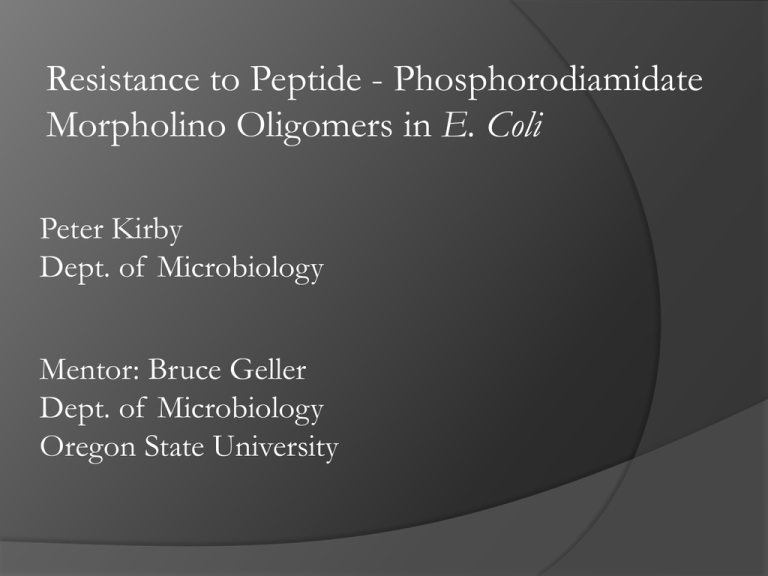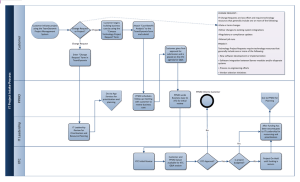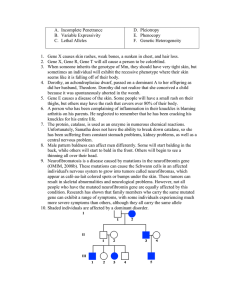Resistance to Peptide - Phosphorodiamidate E. Coli Peter Kirby Dept. of Microbiology
advertisement

Resistance to Peptide - Phosphorodiamidate Morpholino Oligomers in E. Coli Peter Kirby Dept. of Microbiology Mentor: Bruce Geller Dept. of Microbiology Oregon State University Modern Antibiotics and Bacteria Antibiotics target proteins or macromolecular complexes Bacteria can develop resistance to antibiotics 70 percent of the bacteria that cause infections in hospitals are resistant to at least one of the drugs most commonly used for treatment New antibiotics are needed to combat bacteria Phosphorodiamidate Morpholino Oligomers New form of antibiotic PMO’s are synthetic DNA compounds Molecules contains: Phosphorodiamidate backbone Morpholine rings 4 nucleotide bases PMO-Peptide Conjugates PMO’s have a high molecular weight (MW) Have trouble entering Gram-negative bacteria Solution: PMO’s were attached to membranepenetrating peptides PPMO Function PPMO’s are sequence specific PPMO’s hybridize to mRNA near AUG start codons PPMO’s inhibit translation PPMO Action Our Research Project Aim 1: Identify and characterize the mechanisms of resistance to PPMO’s by E. coli Hypothesis: One mechanism of resistance to PPMO’s is caused by mutations in a transporter Strategy: Make random mutation in E. coli, select for resistance to PPMO’s, and identify mutated gene(s) Framework Electroporation: Place bacteria between two electrodes and charging the electrodes with strong potential to open cell wall Transposome: DNA with ability to insert itself into a chromosomal DNA sequence Contains a gene to code for kanamycin resistance Result: Inserting a transposome causes random mutations Produces mutations in all genes in chromosomal DNA Methods Electroporate kanamycin-marked transposomes into E. coli and grow in the presence of PPMO and kanamycin Isolate chromosomal DNA from PPMO-resistant mutants Clone and sequence DNA flanking transposome BLAST E. coli genome to identify gene responsible for mutation and PPMO resistance Results 12 resistant cells discovered 3 strongest colonies selected MIC in Luria-Bertani Broth Antibiotic MIC in Luria-Bertani Broth RXR4-AcpP Antibiotic 06-0076 Parent MIC (μM) XL1-Blue 20 Colony 76.1 76.2 76.3 76.4 76.5 76.6 76.7 76.8 76.9 76.10 76.11 76.12 RXR4-AcpP 06-0076 MIC (μM) 40 80 80 80 80 80 80 40 40 80 40 40 Mutated Gene Isolation Mutated Genes sbmA gene mutated in both 76.2 and 76.3 Function: Predicted Transporter sbmA sbmA: predicted ABC transporter located in inner membrane ABC transporters: Transmembrane protein that uses Adenosine Triphosphate hydrolysis to translocate substances across the membrane Mutated Genes (cont) ADCY (Adenylate Cyclase) gene mutated in 76.10 Function: cAMP dependent pathway Adenylate Cyclase Adenylate Cylcase (ADCY) is essential to the cAMP dependent pathway Catalyzes the conversion of ATP to cyclic adenosine monophosphate (cAMP) ○ Activates CAP binding sites CAP binding site found 200bp from sbmA gene MIC’s in Mueller Hinton II and Brain Heart Infusion Broths MHII Broth Antibiotic RXR4-AcpP 06-0076 Colony MIC (μM) 76.2 10 76.3 10 76.10 -- XL1-Blue 1.25 BHI Broth Antibiotic RXR4-AcpP 06-0076 Colony MIC (μM) 76.2 20 76.3 20 76.10 20 XL1-Blue 5 Conclusion We found two genes that influence E. coli’s resistance to PPMOs sbmA – transporter Adenylate Cyclase – cAMP Acknowledgements Bruce Geller HHMI URISC Kevin Ahern



